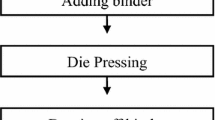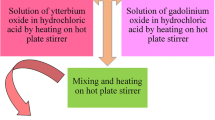Abstract
Yttria-stabilized zirconia (YSZ) co-doped with trivalent oxide Sc2O3 and Yb2O3 is prepared using mechanical alloying and high-temperature sintering. High-temperature XRD analysis was performed to study the phase transformation and lattice parameter changes of various phases in the baseline YSZ and co-doped samples. The results show that the structure for the co-doped samples tends to be more thermally stable at test temperature above critical value. The lattice parameters for all samples increase with temperature at which XRD is carried out, and the lattice parameters for the two trivalent rare earth oxides co-doped YSZ are smaller than that for 7YSZ under the same temperature.










Similar content being viewed by others
References
R.L. Jones, Thermal Barrier Coatings, Metallurgical and Ceramic Protective Coatings, K.H. Stern, Ed., Chapman & Hall, London, 1996,
S.M. Meier and D.K. Gupta, The Evalution of the Thermal Barrier Coatings in Gas-Turbine Engine Applications, J. Eng. Gas Turb. Power, 1994, 116, p 250–257
U. Schulz, C. Leyens, K. Fritscher, M. Peters, B. Saruhan-Brings, O. Lavigne, J.M. Dorvaux, M. Poulain, R. Mevrel, and M.L. Caliez, Some Recent Trends in Research and Technology of Advanced Thermal Barrier Coatings, Aerosp. Sci. Technol., 2003, 7, p 73–80
B. Leclercq, R. Mevrel, V. Liedtke, and W. Hohenauer, Thermal Conductivity of Zirconia-Based Ceramics for Thermal Barrier Coating, Materialwiss. Werkst., 2003, 34, p 406–409
C.G. Levi, Emerging Materials and Processes for Thermal Barrier Systems, Curr. Opin. Solid State Mech., 2004, 8, p 77–91
J.R. Nicholls, K.J. Lawson, A. Johnstone, and D.S. Rickerby, Methods to Reduce the Thermal Conductivity of EB-PVD TBCs, Surf. Coatings Technol., 2002, 151, p 383–391
D. Zhu and R.A. Miller, Thermal Conductivity and Sintering Behaviour of Advanced Thermal Barrier Coatings, Ceram. Eng. Sci. Proc., 2002, 23, p 457–468
J.S. Reed, Principles of Ceramic Processing, 2nd ed., Wiley-Interscience, New York, 1995
I.R. Gibson, G.P. Dransfield, and J.T.S. Irvine, Sinterability of Commercial 8 mol% Yttria-Stabilized Zirconia Powders and the Effect of Sintered Density on the Ionic Conductivity, J. Mater. Sci., 1998, 33, p 4297–4305
M.N. Rahaman, Ceramic Processing and Sintering, 2nd ed., Marcel Dekker, New York, 2003
Material Data Inc. MDI Jade 6 User’s Manual, 2004.
M. Leoni, R.L. Jones, and P. Scardi, Phase Stability of Scandia-Yttria-Stabilized Zirconia TBCs, Surf. Coatings Technol., 1998, 108, p 107–113
W. Wang, S.Q. Qian, and H. Shen, Microstructure and Mechanical Properties of Yttria-Stabilized Zirconia Coatings Produced by Eletrophoretic Deposition and Microwave Sintering, Metall. Mater. Trans. A, 2011, 42A, p 3265–3268
O. Fabrichnaya and H.J. Seifert, Thermodynamic Assessment of the ZrO2-Yb2O3-Al2O3 System, Calphad, 2010, 34, p 206–214
J.H. Zhang, J.S. Yu, X. Cheng, and S.E. Hou, Thermal Expansion and Solubility Limits of Cerium-Doped Lanthanum Zirconates, JAllC, 2012, 525, p 78–81
A. Kuwabara, J. Katamura, Y. Ikuhara, and T. Sakuma, Influence of Interaction Between Neighboring Oxygen Ions on Phase Stability in Cubic Zirconia, J. Am. Ceram. Soc., 2002, 85, p 2557–2561
P. Li, I.W. Chen, and J.E. Pennerhahn, X-Ray-Absorption Studies of Zirconia Polymorphs. 1. Characteristic Local Structures, Phys. Rev. B, 1993, 48, p 10063–10073
A. Dwivedi and A.N. Cormack, A Computer-Simulation Study of the Defect Structure of Calcia-Stabilized Zirconia, Philos. Mag. A, 1990, 61, p 1–22
M. Yashima, N. Ishizawa, and M. Yoshimura, High-Temperature X-RAY STUDY of the Cubic Tetragonal Diffusionless Phase-Transition in the ZrO2-ErO1.5 System. 2. Temperature Dependences of Oxygen-Ion Displacement and Lattice-Parameter of Compositionally Homogeneous 12 Mol-Percent ErO1.5-ZrO2, J. Am. Ceram. Soc., 1993, 76, p 649–656
E.H. Kisi and C.J. Howard, Crystal Structures of Zirconia Phases and Their Inter-Relation, Key Eng. Mater., 1998, 153–154, p 1–36
Author information
Authors and Affiliations
Corresponding author
Rights and permissions
About this article
Cite this article
Jiang, S.L., Huang, X. & He, Z. Phase Transformation and Lattice Parameter Changes of Trivalent Rare Earth Doped YSZ as a Function of Temperature. J. of Materi Eng and Perform 25, 4686–4694 (2016). https://doi.org/10.1007/s11665-016-2328-5
Received:
Revised:
Published:
Issue Date:
DOI: https://doi.org/10.1007/s11665-016-2328-5




